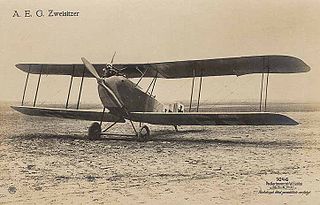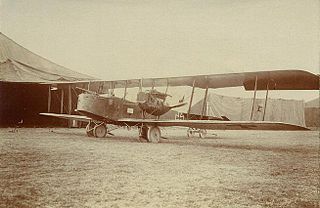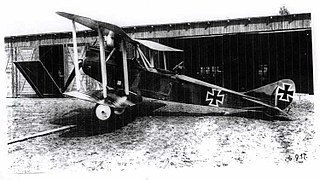
| BFW N.I | |
|---|---|
| Role | Bomber aircraft |
| National origin | Germany |
| Manufacturer | Bayerische Flugzeugwerke (BFW) |
| First flight | summer 1918 |
| Number built | 1 |
The BFW N.I was a prototype night bomber aircraft developed in Germany during the First World War.

| BFW N.I | |
|---|---|
| Role | Bomber aircraft |
| National origin | Germany |
| Manufacturer | Bayerische Flugzeugwerke (BFW) |
| First flight | summer 1918 |
| Number built | 1 |
The BFW N.I was a prototype night bomber aircraft developed in Germany during the First World War.
In August 1917, Idflieg instructed BFW to develop a night bomber able to carry 500 kg of bombs. The resulting N.I was a two-seat triplane powered by one Mercedes D.IVa inline engine. The N.I first flew in the summer of 1918 but did not enter production.
Data from [1]
General characteristics
PerformanceArmament

The Gotha G.V was a heavy bomber used by the Luftstreitkräfte during World War I. Designed for long-range service and built by Gothaer Waggonfabrik AG, the Gotha G.V was used principally as a night bomber.

The AEG C.IV was a two-seat biplane reconnaissance aircraft designed and produced by the German aircraft manufacturer Allgemeine Elektrizitäts-Gesellschaft.

The AEG G.III was a German biplane bomber aircraft of World War I developed from the G.II. Like its predecessor, it was only built in small numbers and saw limited operational use, mainly far from the main fronts of the war.

The AEG G.IV was a biplane bomber aircraft designed and produced by the German aircraft manufacturer Allgemeine Elektrizitäts-Gesellschaft. It saw action during the First World War with the Luftstreitkräfte.

The AEG G.V was a biplane bomber aircraft of World War I, a further refinement of the AEG G.IV. The type saw limited production before the Armistice, and never entered operational service. It featured a 600 kg (1,320 lb) bombload.

The AEG R.I or Riesenflugzeug 1 was a four-engined biplane bomber aircraft of World War I manufactured by AEG.

The Zeppelin-Staaken R.VI was a four-engined German biplane strategic bomber of World War I, and the only Riesenflugzeug design built in any quantity.

The Friedrichshafen G.III was a heavy bomber designed and manufactured by Flugzeugbau Friedrichshafen. They were used by the German Imperial Air Service during World War I for tactical and limited strategic bombing operations. After the end of the war a number of Friedrichshafen bombers were converted into transport aircraft while a small number also saw service as dedicated airliners.

The Mercedes D.IVa was a German six-cylinder, water-cooled, inline engine developed in 1917 for use in aircraft and built by Daimler Motoren Gesellschaft (DMG).

The Friedrichshafen G.IV and G.V respectively were heavy bombers that were designed and manufactured in Germany during World War I by Flugzeugbau Friedrichshafen. The G.IV saw limited use by the Luftstreitkräfte for tactical and limited strategic bombing operations, while the G.V and a follow-on design, the FF.62 did not fly until after the Armistice.

The Gotha G.III was a twin-engine pusher biplane heavy bomber used by the Luftstreitkräfte during World War I. It succeeded the G.II in production and differed primarily in powerplant and in armament details. The G.II's unreliable V-8 Mercedes D.IV was replaced by the new inline six-cylinder 190 kW (250 hp) Mercedes D.IVa engine. The G.III also had a strengthened fuselage with an extra 7.92 mm (0.312 in) machine gun firing through a ventral gun tunnel in the belly to protect the underside of the tail.

The LFG Roland C.II, usually known as the Walfisch (Whale), was an advanced German reconnaissance aircraft of World War I. It was manufactured by Luft-Fahrzeug-Gesellschaft G.m.b.H.

The Rumpler C.IV was a German single-engine, two-seat reconnaissance biplane. It was a development of C.III with different tail surfaces and using a Mercedes D.IVa engine in place of the C.III's Benz Bz.IV. The Rumpler 6B 2 was a single-seat floatplane fighter variant with a 120 kW (160 hp) Mercedes D.III engine built for the Kaiserliche Marine.

The Linke-Hofmann R.II was a bomber aircraft designed and built in Germany from 1917.

The BFW M.20 was a German single-engine, high-wing monoplane ten-seat passenger transport aircraft, developed in the late 1920s and early 1930s. Deutsche Luft Hansa used it throughout the 1930s on a variety of routes.

The DFW R.II was a German bomber aircraft of World War I. It was developed at a request by the Luftstreitkräfte in spring 1917 after their experience with the R.I had been generally positive, but only two were ever built despite six being ordered.

The LVG B.I was a 1910s German two-seat reconnaissance biplane designed by Luft-Verkehrs-Gesellschaft for the Luftstreitkräfte.

The Rumpler G.I was a bomber aircraft produced in Germany during World War I, together with refined versions known as the G.II and G.III.

The Sablatnig N.I was a bomber aircraft developed in Germany during the First World War, a development of the Sablatnig C.I adapted for night operations.

The Halberstadt G.I was a German prototype heavy bomber built by Halberstädter Flugzeugwerke during World War I.